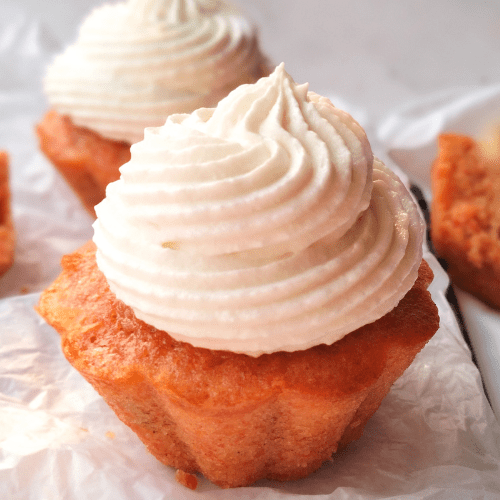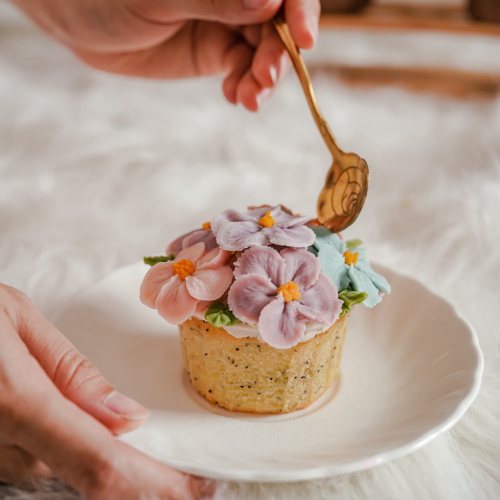AI Can’t Solve This! Here’s Why You Need an Expert
A quick Google search or AI bot might tell you to “just add powdered sugar” to fix runny frosting. But here’s the truth: sugars are hygroscopic—they absorb moisture, which could worsen the problem. (Learn more about the hygroscopic properties of sugar and how it affects baking.) That’s why a pastry chef’s experience is invaluable.
In this blog, I’ll guide you through foolproof ways to fix runny frosting and ensure it turns out perfect every time. And if you’re looking for a no-frosting dessert, check out this simple banana bread recipe.
Table of contents:
- Understanding Frostings
- Why does runny frosting happen?
- What happens if you put too much butter in cookies?
- FAQ
- Recommended recipes
This site contains links that can be considered affiliate links. As an Amazon Associate, I earn from qualifying purchases.
Understanding Frosting: The Basics
Before fixing the frosting, let’s break it down into its components. Most frostings consist of three primary elements:
- Fat: The base of most frostings, from butter to cream cheese or margarine.
- Sugar: Adds sweetness and structure (think powdered sugar or frosting sugar).
- Flavorings: Fruits, extracts, syrups, or spices that elevate the taste.
Understanding the frosting composition makes it easier to troubleshoot. For example, cream cheese frosting can become runny when rose water is added due to excess liquid. Similarly, improper handling can cause issues with buttercream frosting.
Popular types of frosting include:
- Cream Cheese Frosting
- Ermine Frosting
- Buttercream Frosting
Want to explore frostings further? Try making these carrot muffins, which feature a light and fluffy cream cheese frosting.
Why Does Frosting Become Runny?
1. Temperature Issues
In hot climates like India, frosting can melt before it even reaches the table. High indoor temperatures can also wreak havoc in the U.S. on warm days. According to basic pastry science, fats in frosting start breaking down at higher temperatures, leading to runny textures.
2. Hand Temperature
Warm hands can soften frosting too quickly during piping or decorating.
3. Recipe Errors
Using too much liquid, such as strawberry puree, or following an untested recipe can lead to watery results.
How to Fix Runny Frosting: 7 Proven Methods
1. Refrigeration Is Key
Chill the frosting in the refrigerator for 20–30 minutes. If you’re short on time, use an ice bath. Whisk it thoroughly to emulsify the fat and liquid. If you want a more in depth article just about frostings, I will recommend you to check this out.
2. Control Hand Temperature
Cool your hands on ice, or have someone with naturally cooler hands handle the frosting. Avoid letting water droplets mix with the frosting.
3. Adjust the Recipe
- For overly liquid frosting: Incorporate a new batch of fat and emulsify.
- For slightly thin frosting, Add small amounts of cornstarch or powdered sugar to thicken. Avoid overdoing it.
Pro Tip: If you’re making an orange upside-down cake or birthday cake with frosting, ensure your flavoring doesn’t add excess liquid to the mix.
4. Add Heavy Cream or Butter
Both are high-fat options that stabilize frosting. Whipping cream is especially helpful for buttercream.
5. Bloomed Gelatin for Stability
Bloom and melt the gelatin, then mix it into the frosting. Let it sit for a few minutes before using it.
6. Cocoa Powder for Chocolate Frosting
If you’re working with chocolate frosting or ganache, mix in cocoa powder to absorb excess moisture. For more chocolatey fixes, check out my chocolate fudge cake.
7. Fix Ganache with Chopped Chocolate
Add finely chopped chocolate to the ganache while it’s slightly warm (30–40°C). Stir until smooth. This technique works wonders for ganache used in sponge cakes or eggless cakes.
Frequently Asked Questions:
What Is Cornstarch? Is It the Same as Corn Flour?
Yes, they’re the same! Cornstarch is a thickener often added to powdered sugar.
Why Does My Cream Cheese Frosting Become Watery with Rose Water?
Rose water is a highly liquid. Use smaller amounts or opt for rose extract.
Can I Just Add More Powdered Sugar?
Powdered sugar helps to an extent but doesn’t fix structural issues caused by temperature or emulsification problems.
What Is Frosting Sugar?
Frosting sugar is powdered sugar with added cornstarch to prevent clumping.
More posts with frosting:
More Cake Recipes to Explore
- Rasmalai Cake (Eggless)
- Streusel Coffee Cake
- Red Velvet Cake Without Oven
For gluten-free options, try my chocolate fudge cake that doesn’t skimp on flavor.

FOUND THIS HELPFUL?
Tag @alishasdessertsafari on Instagram and hashtag it #alishasdessertsafari
To adjust the consistency, it’s essential to identify the root cause. Whether it’s temperature, recipe, or handling techniques, these fixes ensure you never face runny frosting again. Remember, frosting isn’t just about sugar—it’s an art of balancing fat, liquid, and flavor. Next time AI tells you to “just add sugar,” you’ll know better.
Ready to try these tips? Pair your frosting with my lemon loaf cake or an indulgent sponge cake for flawless results.
Don’t forget to subscribe to get a value-packed newsletter every month and my cookie ebook as a sign-up bonus!
I hope you found my post “How to Fix Runny Frosting: 7 Expert-Approved Solutions” helpful. If you have any queries, feel free to post them in the comments below.
Thank You.






